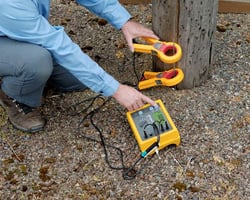By Jack Smith
Why must a facility electrical system have a good electrical ground? In addition to being required by the National Fire Protection Association (NFPA) and the Occupational Safety Health Administration (OSHA), and recommended by the Institute of Electrical and Electronics Engineers (IEEE), American National Standards Institute (ANSI), and the International Electrotechnical Commission (IEC), a well-grounded system increases electrical safety and decreases the odds of equipment damage or failure.
The National Electrical Code (NEC) provides specific requirements for both utility-provided electrical service and separately derived systems. A separately derived system receives power from a source of electrical energy or equipment other than the utility service. This column will address certain aspects associated only with grounding utility-provided electrical service.
Definition of terms
Article 100 of the NEC includes definition of terms essential to the proper application of the code. The following electrical system grounding definitions are from Part I of Article 100:
- Ground: The earth.
- Grounded: Connected to ground or to a conductive body that extends the ground connection.
- Grounded conductor: A system or circuit conductor that is intentionally grounded.
- Equipment grounding conductor: The conductive path (or paths) installed to connect normally non-current-carrying metal parts of equipment together and to the system grounded conductor or to the grounding electrode conductor, or both. It is recognized that the equipment grounding conductor also performs bonding.
- Grounding electrode: A conducting object through which a direct connection to earth is established.
- Grounding electrode conductor: A conductor used to connect the system grounded conductor or the equipment to a grounding electrode or to a point on the grounding electrode system.
Grounding connections
A premises wiring system supplied by a grounded ac service must have a grounding electrode conductor connected to the grounding service conductor. The connection must be made at an accessible point from the load end of the service drop or service lateral to the terminal or bus to which the grounded service conductor is connected at the service disconnect. Service drop refers to overhead conductors; service lateral refers to underground conductors.
If the transformer supplying the service is located outside the building, at least one additional grounding connection must be made from the grounded service conductor to a grounding electrode - either at the transformer or elsewhere outside the building. For services that are dual fed in a common enclosure or grouped together in separate enclosures and use a secondary tie, a single grounding electrode conductor connection to the tie point of the grounded conductors from each power source is allowed.
While earth grounding involves an intentional connection from a circuit or system conductor to a ground electrode placed in the earth, equipment grounding connects the equipment housing or cabinet to a grounding electrode. This circuit or system conductor typically refers to the neutral conductor. Article 250.26 of the NEC specifies which conductor is to be grounded for ac premises wiring systems:
| System wiring configuration | Conductor to be grounded |
|---|---|
| Single-phase, 2-wire | One conductor |
| Single-phase, 3-wire | Neutral conductor |
| Measured V | (Amps) |
| Multi-phase systems with one wire common to all phases | Common conductor |
| Multi-phase systems where one phase is grounded | One phase conductor |
| Multi-phase systems where one phase is grounded One phase conductor | Neutral conductor |
Exposed, normally non-current-carrying metal parts of fixed equipment supplied by or enclosing conductors or components that are likely to become energized must be connected to an equipment grounding conductor if the operating equipment:
- Has any terminals with more than 150 V to ground
- Is located in a wet or damp area and not electrically isolated
- Is subject to human contact
- Is supplied by a wiring method that provides an equipment grounding conductor
Earth ground

Properly grounding a facility's electrical system ensures a low impedance connection from the electrical system to the earth. However, the effectiveness of the earth ground depends on several factors. While the ground electrode placed into the earth should be highly conductive, actual ground resistance depends on the length and depth of the ground electrode placed into the earth, the diameter of the electrode, the actual number of electrodes, the grounding system design, and the actual resistivity - or conductivity - of the soil.
The degree to which soil conducts electricity is both variable and complex. Soil depth affects resistivity, which typically decreases as depth increases. Deep electrode placement can reduce earth ground impedance as can using multiple electrodes. Other factors affecting soil resistivity include soil composition, mineral content, settling and/or compression, temperature (resistivity increases as temperature decreases), and the presence (or absence) of metal objects buried in the soil (such as tanks or pipes).
Because grounding electrodes are subject to oxidation and corrosion and because of the potential for soil resistivity to vary, the integrity of the ground electrode should be tested periodically. Earth grounding systems can be tested using earth ground testers such as models Fluke 1621, Fluke 1625 and Fluke 1623, and Fluke 1630 available from Fluke. Earth ground testers measure ground resistivity by applying a voltage to the electrode and measuring the resulting current. Fluke offers a great deal of information about earth ground testing on its website.
Closing the loop
I have been writing this column for more than two years. However, this is my last "Solid Ground" column for Fluke, as I am embarking on another endeavor. CFE Media LLC has appointed me as editor of Applied Automation, a bimonthly supplement to Control Engineering and Plant Engineeringmagazines, beginning with the August 2012 issue.
As I wrote in my first column, I want to extend a big "thank you" to Fluke for inviting me to write this column. I have enjoyed writing every one of them. I will truly miss it.
Moving forward, I urge you to keep standing on "Solid Ground."